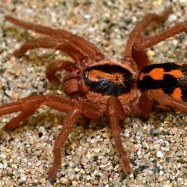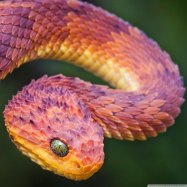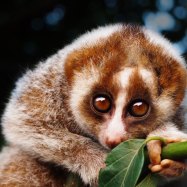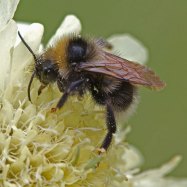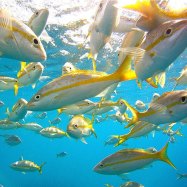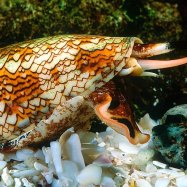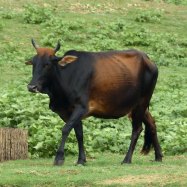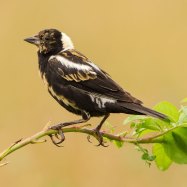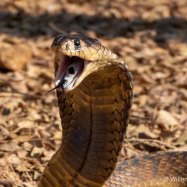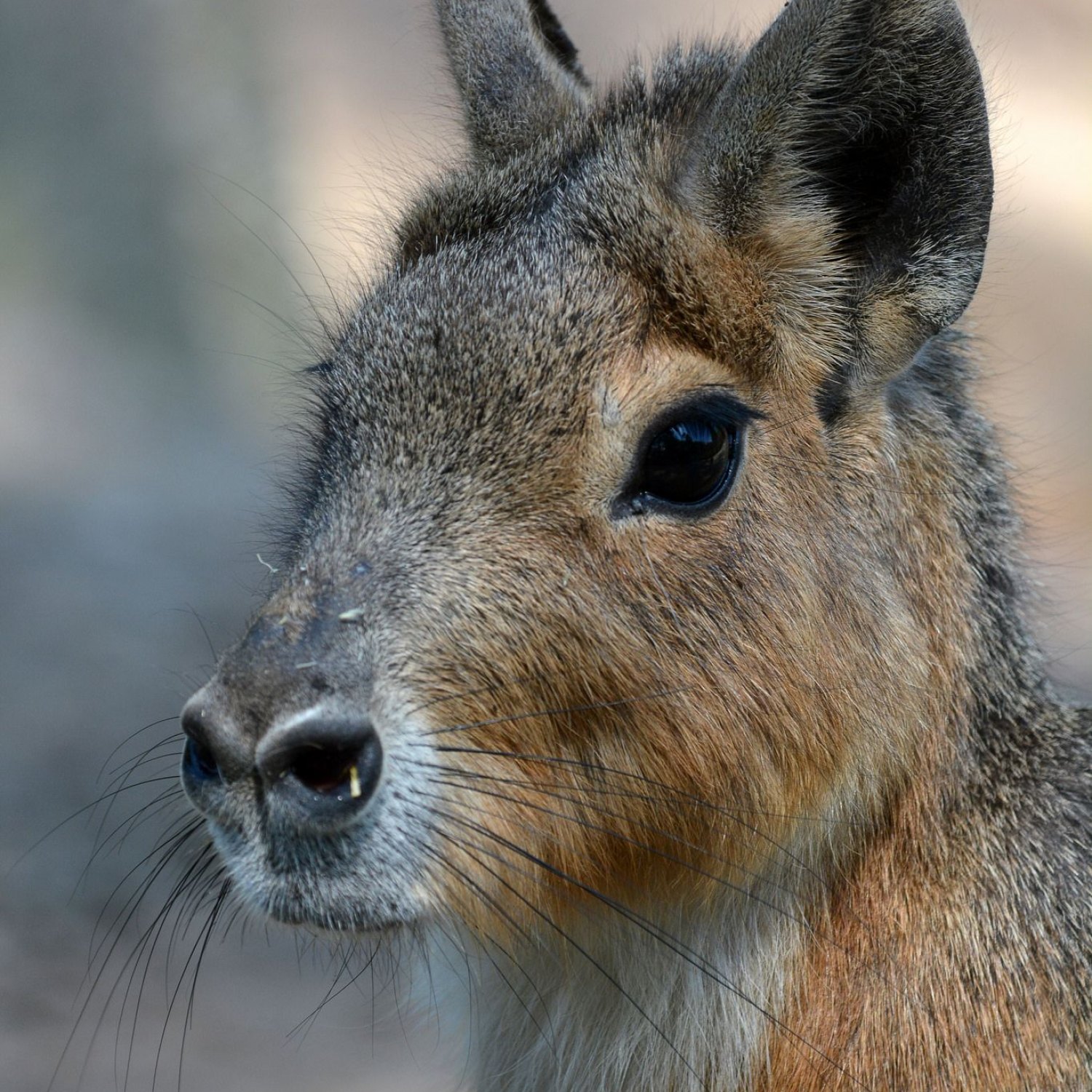
Patagonian Mara
60-75 cm
The Patagonian Mara is a unique animal found in the grasslands of Patagonia. These small, cylindrical-shaped animals belong to the Caviidae family and typically grow to about 60-75 cm in length. With their cute appearance and interesting behavior, they are a popular sight for tourists visiting Patagonia. They are also known as the Patagonian cavy or the Patagonian hare. Visit Patagonia to catch a glimpse of these adorable creatures.
Animal Details Summary:
Common Name: Patagonian Mara
Kingdom: Animalia
Habitat: Grasslands
The Fascinating World of Patagonian Mara
The vast, windswept plains of Patagonia in southern Argentina and Chile are home to a unique and fascinating creature - the Patagonian Mara. Also known as the Patagonian cavy, the Patagonian hare, or the dillaby, this animal boasts both curious behavior and physical characteristics that make it stand out from its mammalian counterparts.The Patagonian Mara, with its scientific name Dolichotis patagonum, belongs to the kingdom Animalia and the phylum Chordata. It falls under the class Mammalia, the order Rodentia, and the family Caviidae Patagonian Mara. This fascinating creature is native to Argentina, where it is found in the vast grasslands of Patagonia.
From its unique appearance to its dietary habits and behaviors, there is much to learn and appreciate about the Patagonian Mara. In this article, we will dive into its world and explore its remarkable features in detail.
Appearance and Physical Characteristics
The Patagonian Mara is a medium-sized mammal with a cylindrical body shape, growing up to 60-75 cm in length and 45-50 cm in height. Its body is covered in thick, soft fur that is brown in color with a white belly. This coloration provides camouflage in its grassland habitat, allowing it to blend in with its surroundings and avoid detection from predators.One of the most striking features of the Patagonian Mara is its long, powerful hind legs that are adapted for running and jumping. These legs are also equipped with sharp claws that allow the animal to dig for food and create burrows for shelter.
Habitat and Distribution
As its name suggests, the Patagonian Mara is primarily found in Patagonia, in the southern parts of Argentina and Chile Peruvian Inca Orchid. This region is characterized by vast, open grasslands that provide the perfect habitat for these animals. They are also known to inhabit scrublands and shrub forests in addition to grasslands.The Patagonian Mara is highly adaptable and can thrive in a variety of habitats as long as there is enough food and shelter. However, human activity and habitat destruction have resulted in a decline in their population, leading to their classification as near-threatened on the IUCN Red List.
Diet and Feeding Habits
The Patagonian Mara is a herbivorous animal, feeding on a variety of vegetation such as grasses, leaves, fruits, and seeds. They are known to have a selective diet, choosing the most nutrient-rich parts of plants and avoiding toxic or unpalatable ones.Interestingly, Patagonian Maras have a unique way of obtaining nutrients from food. Instead of chewing their food, they swallow it whole and then regurgitate it several times before finally digesting it. This process, known as 'rumination,' allows them to break down tough plant material and extract all the nutrients from it.
Behavior and Social Structure
The Patagonian Mara is a highly social animal and lives in groups called 'harems.' A harem usually consists of one male, several females, and their offspring. These animals are monogamous, meaning that they mate for life and the male takes an active role in raising the young.Within the harem, there is a strict hierarchy, with the male being the dominant member and the females ranked in descending order. This hierarchy is maintained through various behaviors, such as chasing and aggressive displays.
In addition to living in harems, Patagonian Maras also engage in a unique behavior known as 'pronking.' Pronking is a display of high-speed hops and leaps, often performed by female Maras during mating season. This behavior may serve to attract males or to assert dominance within the harem.
These animals are also known to be territorial and use various vocalizations and scent marking to communicate with members of their group and ward off potential intruders.
Conservation Efforts
As mentioned earlier, the population of Patagonian Maras is declining due to habitat destruction and human activity. However, conservation efforts have been put in place to protect this unique species.In their natural habitats, Patagonian Maras are often preyed upon by native predators such as pumas, foxes, and birds of prey. To mitigate this, conservationists have introduced them to protected areas where their populations are closely monitored and protected from predators.
In addition, efforts have been made to educate local communities on the importance of preserving these animals and their habitats. These initiatives have helped raise awareness and promote sustainable practices to protect the Patagonian Mara and other unique species in the area.
In Conclusion
The Patagonian Mara is a fascinating creature, with its unique physical characteristics and curious behaviors. Despite being near-threatened, this animal continues to captivate the hearts of many and inspire conservation efforts to protect its future.From its long, powerful hind legs and selective diet to its monogamous social structure and high-speed pronking, the Patagonian Mara is a prime example of adaption and survival in a harsh environment. With continued efforts towards preservation and education, we can ensure that this remarkable species continues to thrive in the vast grasslands of Patagonia.

Patagonian Mara
Animal Details Patagonian Mara - Scientific Name: Dolichotis patagonum
- Category: Animals P
- Scientific Name: Dolichotis patagonum
- Common Name: Patagonian Mara
- Kingdom: Animalia
- Phylum: Chordata
- Class: Mammalia
- Order: Rodentia
- Family: Caviidae
- Habitat: Grasslands
- Feeding Method: Herbivorous
- Geographical Distribution: Southern Argentina and Chile
- Country of Origin: Argentina
- Location: Patagonia
- Animal Coloration: Brown with a white belly
- Body Shape: Cylindrical
- Length: 60-75 cm
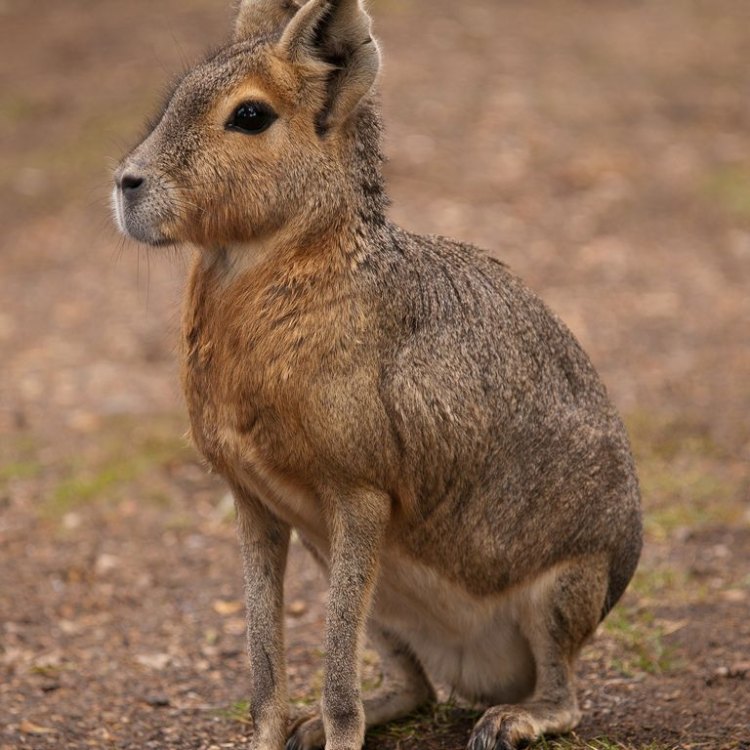
Patagonian Mara
- Adult Size: 10-16 kg
- Average Lifespan: 10-14 years
- Reproduction: Sexual
- Reproductive Behavior: Monogamous
- Sound or Call: Loud alarm calls
- Migration Pattern: Non-migratory
- Social Groups: Monogamous pairs and family groups
- Behavior: Social, diurnal, and terrestrial
- Threats: Habitat loss and hunting
- Conservation Status: Near Threatened
- Impact on Ecosystem: Important ecological role as a primary consumer and seed disperser
- Human Use: Hunted for food and fur
- Distinctive Features: Long legs, rabbit-like appearance, and elongated ears
- Interesting Facts: Patagonian Maras are also known as 'Patagonian hares' but they are not true hares.
- Predator: Pumas, foxes, and birds of prey
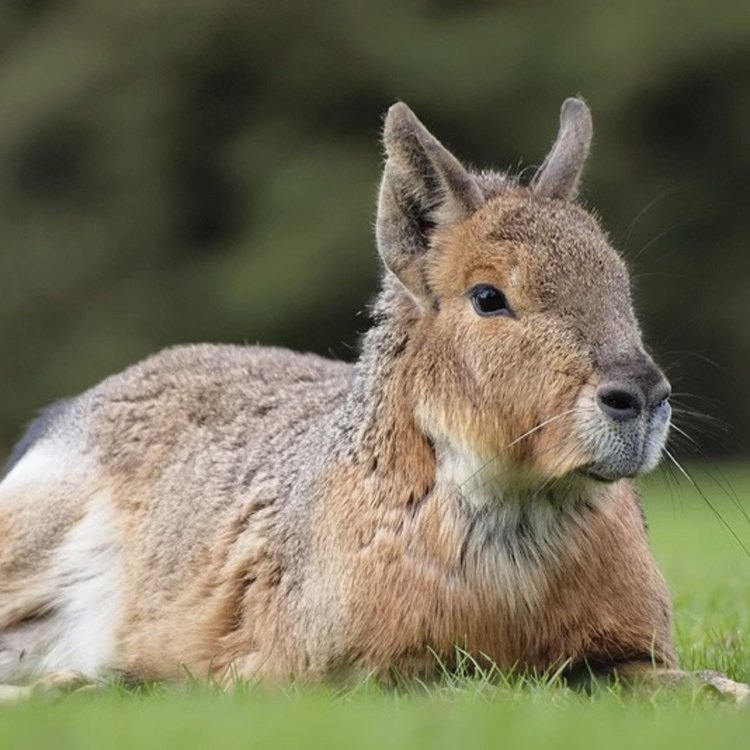
Dolichotis patagonum
The Fascinating World of the Patagonian Mara
From the sprawling grasslands of Patagonia, in South America, emerges a curious creature that resembles a mix between a rabbit and a deer. With their long legs, rabbit-like appearance, and elongated ears, the Patagonian Mara is a unique and fascinating species that demands our attention. In this article, we will explore the fascinating world of the Patagonian Mara, from its physical characteristics to its behavior, and the important role it plays in its ecosystem.The Patagonian Mara, Dolichotis patagonum, is a rodent species that belongs to the cavy family, along with guinea pigs and capybaras PeaceOfAnimals.Com. They are also known as Patagonian hares, but contrary to popular belief, they are not true hares. This is due to their physical resemblance to hares, with their long hind legs and ears, used for hopping and detecting potential predators.
Adult Patagonian Maras can weigh anywhere from 10 to 16 kilograms, making them one of the largest species of cavies. They have a distinctively hare-like appearance, with their brownish-grey fur and large back feet that are used for jumping and running. These long limbs and strong hindquarters make them incredibly agile and fast, allowing them to escape predators in the open grasslands.
The Patagonian Mara has an average lifespan of 10 to 14 years, with the females living slightly longer than males. They reach sexual maturity at around 1 year of age and reproduce sexually. Mating typically occurs in the austral spring, between October and December. Interestingly, these mammals exhibit a monogamous reproductive behavior, where a male and female will form a pair bond that will last for life Parakeet. This is a rare occurrence in the animal kingdom, making the Patagonian Mara a truly unique species.
Like most rodents, the Patagonian Mara is known for its prolific breeding. Females can give birth to up to six offspring at a time, after a gestation period of around 90 days. The young are born fully furred and with their eyes open, and they are able to run within minutes after birth. This is an important adaptation for survival in the open grasslands, where predators are always on the lookout for their next meal.
Apart from their monogamous reproductive behavior, Patagonian Maras are also highly social animals. They live in groups that consist of monogamous pairs and their young offspring. These family groups can range from five to more than 30 individuals, making them a tight-knit community. They are also diurnal, meaning they are active during the day, and they are strictly terrestrial, rarely venturing into the trees.
Within the social structure of the Patagonian Mara, the females play a crucial role in protecting and raising their young. They are known to be fiercely protective of their offspring and will even defend their territory against predators. This is important for the survival of their young, as they are vulnerable to predation from pumas, foxes, and birds of prey.
One of the most distinct features of the Patagonian Mara is their loud alarm calls. These vocalizations are used to communicate danger, and they can be heard up to 1 km away. When a predator approaches, the maras will let out a series of loud, high-pitched alarm calls, alerting the entire group to take cover. This unique adaptation helps them to survive in their harsh and unpredictable environment.
The Patagonian Mara is a non-migratory species, meaning they do not undertake long-distance seasonal movements. They are endemic to the grasslands of Patagonia, and they are perfectly adapted to thrive in this environment. However, this has also made them highly vulnerable to the impacts of habitat loss and hunting.
Human activity, such as agriculture and urbanization, has resulted in the destruction of large areas of grasslands in Patagonia, leading to a decline in the Patagonian Mara population. They are also hunted for their meat and fur, which are used in traditional clothing by indigenous communities. These threats have resulted in the International Union for Conservation of Nature (IUCN) listing the Patagonian Mara as a Near Threatened species.
The protection and conservation of the Patagonian Mara are crucial not only for the survival of this unique species but also for the health of its ecosystem. As primary consumers, they play an important role in regulating plant growth and maintaining a balance in the grassland food chain. Additionally, their voracious appetite for seeds and fruits makes them important seed dispersers, aiding in the regrowth and regeneration of plant species.
In conclusion, the Patagonian Mara is a truly remarkable creature, with its rabbit-like appearance, monogamous behavior, and loud alarm calls. While they may appear cute and harmless, they play a vital role in their ecosystem and are facing various threats to their survival. It is our responsibility to protect and conserve this unique species, not only for their own sake but for the health and balance of the Patagonian grasslands.
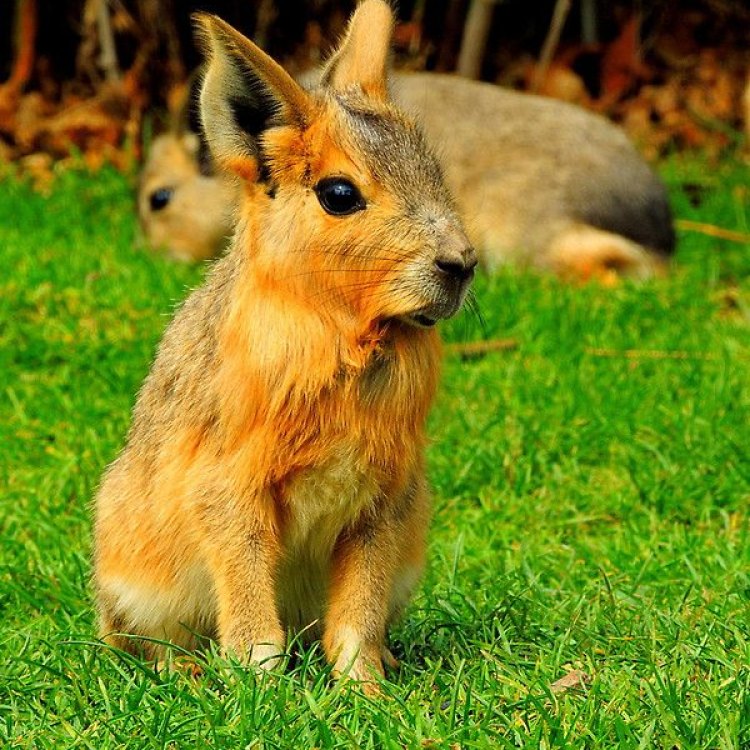
The Fascinating World of Patagonian Mara
Disclaimer: The content provided is for informational purposes only. We cannot guarantee the accuracy of the information on this page 100%. All information provided here may change without prior notice.

